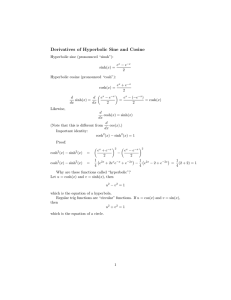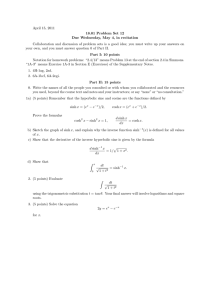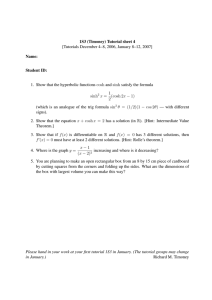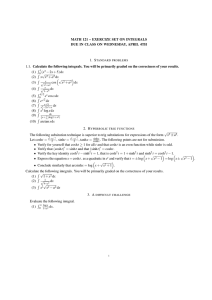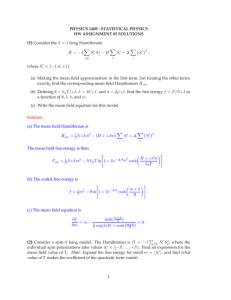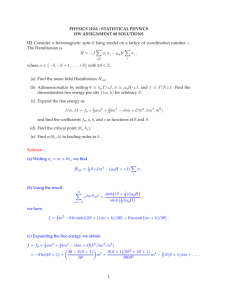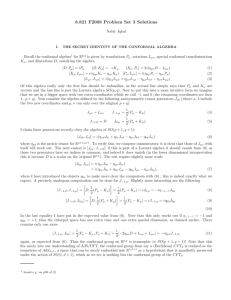Quantum Mechanics C (Physics 212A) Fall 2015 Worksheet 6 – Solutions
advertisement
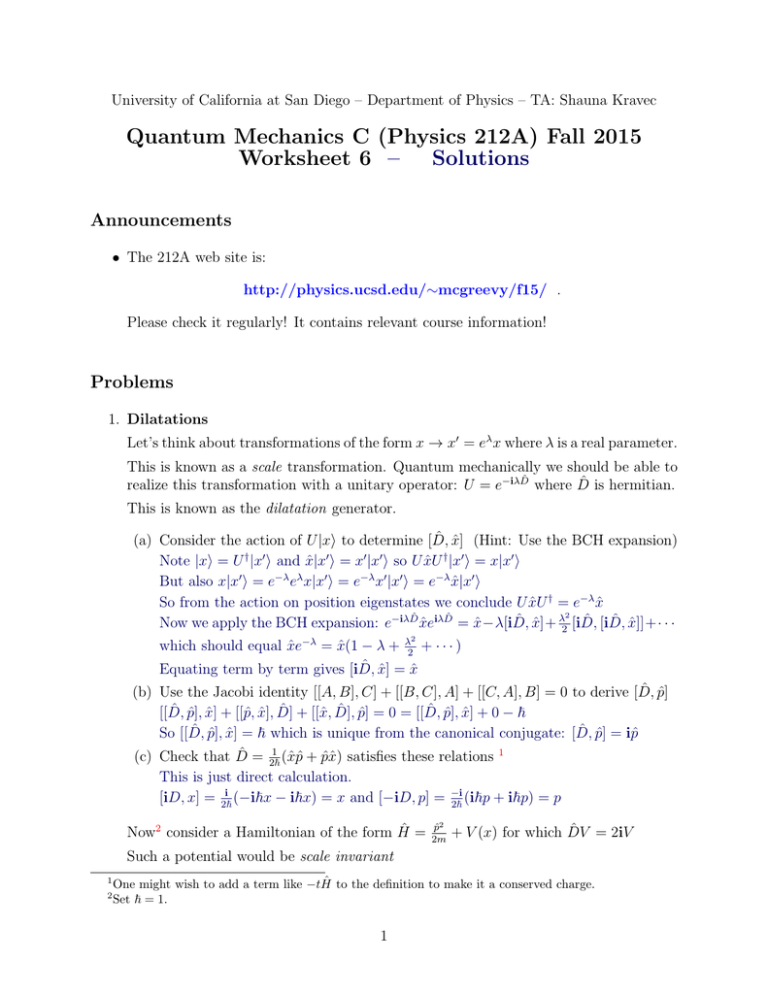
University of California at San Diego – Department of Physics – TA: Shauna Kravec
Quantum Mechanics C (Physics 212A) Fall 2015
Worksheet 6 –
Solutions
Announcements
• The 212A web site is:
http://physics.ucsd.edu/∼mcgreevy/f15/ .
Please check it regularly! It contains relevant course information!
Problems
1. Dilatations
Let’s think about transformations of the form x → x0 = eλ x where λ is a real parameter.
This is known as a scale transformation. Quantum mechanically we should be able to
realize this transformation with a unitary operator: U = e−iλD̂ where D̂ is hermitian.
This is known as the dilatation generator.
(a) Consider the action of U |xi to determine [D̂, x̂] (Hint: Use the BCH expansion)
Note |xi = U † |x0 i and x̂|x0 i = x0 |x0 i so U x̂U † |x0 i = x|x0 i
But also x|x0 i = e−λ eλ x|x0 i = e−λ x0 |x0 i = e−λ x̂|x0 i
So from the action on position eigenstates we conclude U x̂U † = e−λ x̂
2
Now we apply the BCH expansion: e−iλD̂ x̂eiλD̂ = x̂−λ[iD̂, x̂]+ λ2 [iD̂, [iD̂, x̂]]+· · ·
which should equal x̂e−λ = x̂(1 − λ +
λ2
2
+ ···)
Equating term by term gives [iD̂, x̂] = x̂
(b) Use the Jacobi identity [[A, B], C] + [[B, C], A] + [[C, A], B] = 0 to derive [D̂, p̂]
[[D̂, p̂], x̂] + [[p̂, x̂], D̂] + [[x̂, D̂], p̂] = 0 = [[D̂, p̂], x̂] + 0 − ~
So [[D̂, p̂], x̂] = ~ which is unique from the canonical conjugate: [D̂, p̂] = ip̂
1
(c) Check that D̂ = 2~
(x̂p̂ + p̂x̂) satisfies these relations 1
This is just direct calculation.
[iD, x] = 2~i (−i~x − i~x) = x and [−iD, p] = −i
(i~p + i~p) = p
2~
Now2 consider a Hamiltonian of the form Ĥ =
p̂2
2m
+ V (x) for which D̂V = 2iV
Such a potential would be scale invariant
1
2
One might wish to add a term like −tĤ to the definition to make it a conserved charge.
Set ~ = 1.
1
(d) Calculate [D̂, Ĥ] explicitly
p2
] + [D, V ]. Let’s go term by term.
[D̂, Ĥ] = [D, 2m
[D, V ] = 21 ([xp, V ] + [px, V ]) = 12 (x[p, V ] + [p, V ]x) = 2i1 (x∂x V + ∂x V x) = D̂V
But by assumption DV = 2iV
p2
p2
1
1
[D, 2m
] = 4m
([xp, p2 ]+[px, p2 ]) = 4m
([x, p2 ]p+p[x, p2 ]) = 2i( 2m
) using [x, p2 ] = 2ip
Together [D, H] = 2iH
(e) Show that V (x) = x12 is an example of such a potential
DV = 2i1 (x∂x V + ∂x V x) but ∂x ( x12 ) = − x23 so DV = 2i ( x42 ) = 2iV
(f) Consider an energy eigenstate |Ei and calculate hE|[D̂, Ĥ]|Ei directly and with
the result above. Do you see a problem?
First directly hE|[D̂, Ĥ]|Ei = hDHi − hHDi = EhDi − EhDi = 0
where I’ve used the fact Ĥ is Hermitian
However hE|[D̂, Ĥ]|Ei = 2ihHi = 2iE 6= 0
Thus we have an apparent contradiction! What does this mean? One of two
possible outcomes resolve this issue.
One possibility is that the scale symmetry is anomalous and is broken by the high
energy gerbils in the problem. This is the situation for the x12 potential where the
issue is ultimate from the singular behaviour at x = 0
Another possibility is that hDi is not well defined. This can happen if D̂|Ei is
not in the Hilbert space. This situation is realized for the free particle case.
2. Bogliubov Transformation
In our last discussion we solved a new Hamiltonian by defining a set of transformed
creation/annihilation operators which satisfy the same algebra [A, A† ] = 1
More generally consider b̂ = â cosh η + ↠sinh η
(a) Show that [b̂, b̂† ] = 1
[b̂, b̂† ] = cosh2 η[a, a† ] − sinh2 η[a, a† ] = 1[a, a† ] = 1
η
† †
(b) Show that b̂ = U âU † for U = e 2 (ââ−â â )
Time to bust out BCH: U âU † = â + [A, a] + 12 [A, [A, a]] + · · ·
Where A ≡ η2 (ââ − ↠↠). Note [a† a† , a] = −2a† and [aa, a† ] = 2a
So [A, a] = ηa† and [A, [A, a]] = η[A, a† ] = η 2 a
So everything decomposes into odd terms with a† and even terms a. All plus
signs. This gives the form of b
(c) Show for fermionic operators ĉ2 = 0 = (ĉ† )2 and {ĉ, ĉ† } = 1 that
dˆ = ĉ cos θ + ĉ† sin θ is the analogous operator
Similar but the anticommutation means {d, d† } = cos2 θ{ĉ, ĉ† } + sin2 θ{ĉ, ĉ† } = 1
Now consider the Hamiltonian
Ĥ = ω↠â +
2
V
(ââ + ↠↠)
2
(1)
(c) Diagonalize the Hamiltonian (1) using the b̂ operators for suitably chosen η
We should look for an operator of the form H = Ωb† b + F for some constant F
b† b = (cosh2 η + sinh2 η)a† a + sinh2 η + cosh η sinh η(aa + a† a† )
So Ω cosh(2η) = ω and Ω sinh(2η) = V =⇒ V = ω tanh(2η)
It also must be that Ω sinh2 η + F = 0 ; solving for Ω and F independently is just
algebra. Ω = ω cosh(2η) − V sinh(2η)
The spectrum is simple now though! En = Ωn + F
(d) Show there is a limit on V for which this Hamiltonian makes physical sense
2
ω
= ωV
Ω must be positive. ω cosh(2η) > V sinh(2η) =⇒ V < tanh(2η)
Thus V < ω
3

